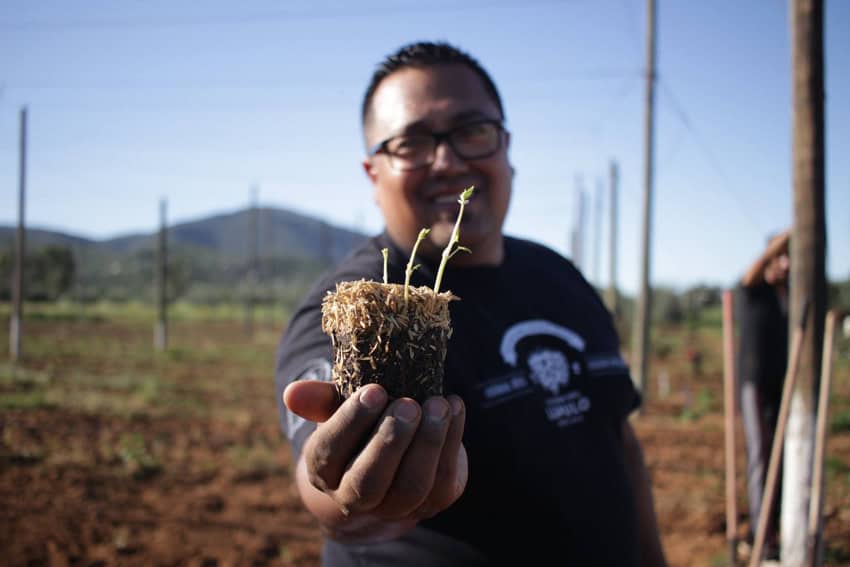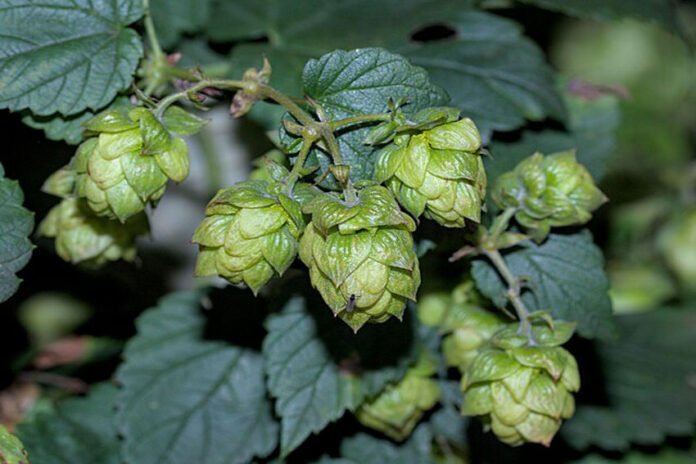Mexico is the world’s number one beer exporting country and No. 22 in overall beer consumption. But while beer has been produced here in commercial quantities since the 1800s, until 14 years ago, 100% of the hops used in Mexican beer were imported from abroad, at a price tag of more than US $34 million a year.
While the idea of a 100% Mexican beer has been dreamt of before, it’s taken a long time for it to become a reality.

“Since we started [brewing] 12 years ago, it has always been our goal to have beer not only made in Mexico, but made of Mexico,” says Matias Veracruz, co-owner and brewer at Monstruo de Agua brewery in Mexico City. “When we started, everyone imported everything, and there were no national vendors of malt or hops or anything. So it was always our goal to find Mexican hops.”
Monstruo de Agua, like most craft brewers in Mexico, historically got their hops from the northwest United States: specifically in Washington state’s Yakima Valley, in Oregon and in Idaho. Along the same latitude are the hops grown in Germany, the Czech Republic, Slovenia and China. On the far end of the globe, you will find production in Australia, Argentina, Chile and New Zealand.
There’s a correlation between these places and the requirements of hops: short but intense, light-filled summers (about 16 hours of sunlight a day) and a winter period that’s not too chilly. Mexico, with its almost-even hours of light and dark year-round, is not ideal, but growers here have been trying to make it work for the last 15 years.
Miguel Loza started what was likely the first hops project in the country, planting in 2011 in Valle de Guadalupe, Mexico’s famed wine region. Originally from Ensenada, Loza started making his own beer when he was living in San Diego and decided to move back to Ensenada to try his hand at growing hops.
“I was totally on my own,” he says. “The only people I could ask questions to were in Oregon or Washington. I didn’t have a mentor or anything. I remember one person told me I should just grow avocados or something else because hops would never grow in Mexico.”
But they did grow. At the height of his project, Loza was able to obtain about a kilo and a half of hops from each of his 1,200 plants. Even that, he admits, was difficult; growing directly in the ground caused accidental cross-pollination of varieties, changes in flavor profiles due to the specific terroir where the hops were being grown and reduced control over the plants’ health.

Hops, much like grapes, are the type of plant that’s particularly sensitive to the ecosystem it inhabits. Water, soil, nutrients — even human touch — can affect the way the flowers taste, smell and act during growth. It’s part of what makes this plant interesting, but also what makes it complicated.
Loza eventually had to give up the farm in Ensenada when his daughter got sick and his family moved to Texas, but he still grows a small amount of hops for his own personal use.
“It was always more of a labor of love,” he says, “I knew I would never make any money. It was more for the satisfaction of being able to say we have 100% Mexican hops.”
Nine years later in 2020, Daniele Gamba started Lupex in Jalisco. A much smaller and more experimental project, Gamba worked in conjunction with the local university, growing less than 100 plants of five different varieties. These hops were planted directly in the ground with the addition of grow lights to control the plants’ flowering phase and to give them their required 16 hours of summer sunlight.
According to Gamba, they were able to achieve two yearly harvests of about 3.5 kilograms of hops per plant — an astounding amount since the average yield per plant hovers around 2 kilograms.
In the end, Gamba didn’t have enough land (he judged he would need 5 hectares to make the project economically feasible), nor could he find any local farmers willing to take on hops production, even with his technical support.
Also in 2020, Claudia Viloria and her partner Pepe Iracheta began Lúpulos Igor in Zacatlán de las Manzanas, Puebla. They currently have the oldest plants of any project — the hops that they are growing hydroponically in a greenhouse are three years old.
“The craft beer industry is growing a lot and quickly, and now with the issue of the tariffs, it’s going to be even more difficult to import supplies,” says Claudia. “We’re an alternative, especially for many brewers looking to create a product that’s 100% Mexican. There aren’t that many hops producers, and to be able to [provide for the demand], we will have to work together.”
Lúpulos Igor’s 400 plants produced between 40–50 kilograms in each of their first two growth cycles, and this year, as the plants reach full maturity, Claudia hopes each will produce 1 kilogram. They’ve been working with Monstruo de Agua, Pecados de la Malta and other craft brewers, but don’t yet have the production to commit to big contracts. Their future goal is 10,000 plants, which will require a substantial investment.
“It’s a good thing that we have other jobs,” she says, chuckling. Claudia works in public policy and Pepe is an urban planner. “Our work allows us to support this project, but setting it up and keeping it running is a big investment.”
View this post on Instagram
Some of the latest crop growing at Lúpulos Igor.
“When I first met the people from Lúpulos Igor, I basically purchased all the hops they had on them,” says Orlando Lara of Pecados de la Malta. “The beer we made with it won awards in Mexico, Colombia and Peru. We were thrilled. If you buy at supply stores, much of [the hops] is repackaged, previously opened, old, with lots of quality issues. So, instead, I started to buy directly from Yakima Valley in Washington or New Zealand, but the delivery takes time, and that also degrades the quality. The resin flavors of Lúpulos Igor’s experimental varieties, you are never going to find in prepackaged hops.”
In 2022, the most recent hops project, GroAltos, was formalized after Oscar Martínez and his partner made a first unsuccessful attempt to grow hops in Chiapas. In 2022, they planted on land outside of Guadalajara but struggled with the first round of plants. They now have 1,500 one-year-old plants on less than a hectare of land, but they hope to expand to 50 times that size one day.
How viable is the budding Mexican hops industry? In my conversations with growers and beer makers, I felt a tentative optimism saddled with a touch of frustration at the barriers.
What is obvious is that there is little communication and information shared among growers themselves, despite their seemingly strong relationships with local brewers.
“I had people tell me don’t talk about the lamps you are using, don’t give away your information,” says GroAltos’ Martínez. “But at the end of the day, in order for the industry to grow, there has to be some level of transparency. By hiding the information, you make yourself feel important, but the truth is you’re just like everyone else; what’s really valuable is your [personal] experience.”
Another concern I heard repeated was the cost of building the necessary infrastructure (in all cases, trestles; in others, lamps, greenhouses and hydroponic systems).
Gamba floated the idea that brewers could come together to support growers, as investors who could be paid back in harvest. But Martínez points out that local hops are an unnecessary luxury to many brewers who have access to high-quality hops imported from the U.S. at a decent price. He instead believes that the push should be for greater government support.

“Not that there’s [no government support], but there needs to be more awareness developed that hops are strategic for the beer industry — one of Mexico’s biggest exports, and that this has to do with commercial sovereignty.”
From a sustainability perspective, there’s an assumption that the cost to set up and run a hops farm is much less than the energy costs to import them from 2,600 miles away. But more study is needed to come up with the hard data on what makes the most sense environmentally — a question that can no longer be left out of any cost-benefit analysis in our era of climate change.
Other barriers seem easier to overcome. With time and professionalization, the idea of Mexican hops will seem less risky and wild. In the same way that the vineyards of the Bajío region, for example, took several years to start producing top-quality wine, these nascent hops growers are likely to produce a better product year over year as their expertise grows, as the plants adapt and mature and as growers better understand the requirements of growing hops on Mexican soil.
And the benefits of local hops are many: interesting flavor profiles, increased freshness, less dependence on international sources, easier and faster delivery and the reinvestment of money into local business owners and farmers. Brands like Monstruo de Agua, Pecados de la Malta and others for whom making 100% Mexican beer is a priority, look poised to continue supporting this burgeoning industry, and I, for one, am excited about the future of hops in Mexico.
Lydia Carey is a freelance writer and translator based out of Mexico City. She has been published widely both online and in print, writing about Mexico for over a decade. She lives a double life as a local tour guide and is the author of “Mexico City Streets: La Roma.” Follow her urban adventures on Instagram and see more of her work at mexicocitystreets.com.
